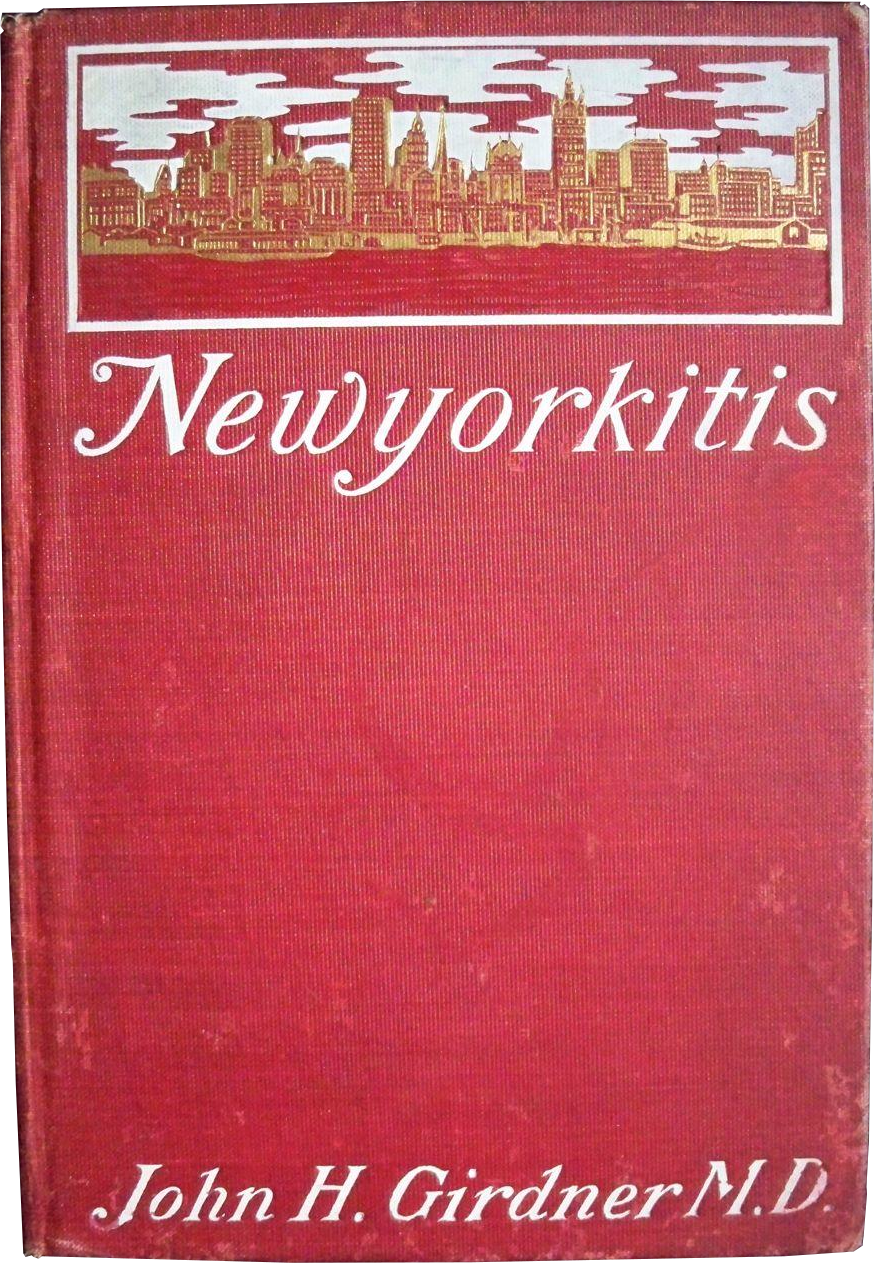Newyorkitis 1901 Edition on:
[Wikipedia]
[Google]
[Amazon]
 ''Newyorkitis'' is a 1901 book by surgeon John H. Girdner describing "a condition of mind, body, and soul" that he had observed among patients living in the
''Newyorkitis'' is a 1901 book by surgeon John H. Girdner describing "a condition of mind, body, and soul" that he had observed among patients living in the
'' a tongue-in-cheek book... satirizing the provincialism of life in New York City."
A 2020 ''
 ''Newyorkitis'' is a 1901 book by surgeon John H. Girdner describing "a condition of mind, body, and soul" that he had observed among patients living in the
''Newyorkitis'' is a 1901 book by surgeon John H. Girdner describing "a condition of mind, body, and soul" that he had observed among patients living in the New York City
New York, often called New York City or NYC, is the List of United States cities by population, most populous city in the United States. With a 2020 population of 8,804,190 distributed over , New York City is also the L ...
borough of Manhattan
Manhattan (), known regionally as the City, is the most densely populated and geographically smallest of the five boroughs of New York City. The borough is also coextensive with New York County, one of the original counties of the U.S. state ...
.
John Harvey Girdner (author)
John H. Girdner (March 8, 1856October 27, 1933) was a prominent New York surgeon and an associate of the noted surgeon Frank Hamilton, with whom he attended President James Garfield after Garfield was shot in 1881. Girdner was the inventor of a "telephonic bullet probe" that came into use before the first x-rays, and was a pioneer inskin grafting
Skin grafting, a type of graft surgery, involves the transplantation of skin. The transplanted tissue is called a skin graft.
Surgeons may use skin grafting to treat:
* extensive wounding or trauma
* burns
* areas of extensive skin loss due ...
. He taught at medical schools and was the author of numerous satirical and philosophical articles for magazines.
The "affliction"
Girdner ascribed a variety of physical symptoms to living in Manhattan, includingnearsightedness
Near-sightedness, also known as myopia and short-sightedness, is an eye disease where light focuses in front of, instead of on, the retina. As a result, distant objects appear blurry while close objects appear normal. Other symptoms may include ...
caused by the presence of buildings in all directions, ears irritated by constant noise, and a "rapidity and nervousness and lack of deliberation in all muscular movements."
"Newyorkitis" symptoms also included "haste, rudeness, restlessness, arrogance, contemptuousness, excitability, anxiety, pursuit of novelty and of grandeur, pretensions of omniscience, and therefore prescience, which of course undermines any pleasure taken in novelty."
''Newyorkitis'' was described as "satirical" in obituaries at the time of Girdner's death, and in reviews at the time of publication. The ''Brooklyn Eagle
:''This article covers both the historical newspaper (1841–1955, 1960–1963), as well as an unrelated new Brooklyn Daily Eagle starting 1996 published currently''
The ''Brooklyn Eagle'' (originally joint name ''The Brooklyn Eagle'' and ''King ...
s review said that "most people have declared that a vein of sarcasm
Sarcasm is the caustic use of words, often in a humorous way, to mock someone or something. Sarcasm may employ ambivalence, although it is not necessarily ironic. Most noticeable in spoken word, sarcasm is mainly distinguished by the inflection ...
, or satire, runs through the book", and another review described it as an "amusing satire." The ''Kansas City Press'' observed in 1901: "We suppose that the author intends his book as a serious criticism of New York conditions, however it is impossible that any one with a sense of humor should be able to read the book without an appreciation of its satire, whether intentional or not."
''The New York Times
''The New York Times'' (''the Times'', ''NYT'', or the Gray Lady) is a daily newspaper based in New York City with a worldwide readership reported in 2020 to comprise a declining 840,000 paid print subscribers, and a growing 6 million paid ...
'' reported in 2001 that a family history described ''Newyorkitis'' as Lapham's Quarterly
''Lapham's Quarterly'' is a literary magazine established in 2007 by former '' Harper's Magazine'' editor Lewis H. Lapham. Each issue examines a theme using primary source material from history. The inaugural issue "States of War" contained doze ...
'' article, however, observed that the press "saw evidence of Girdner’s syndrome everywhere." A ''New York Tribune'' article on "Newyorkitis" reported in 1905 that “there were three thousand cases of men falling dead or dying suddenly, an increase of five hundred over any previous year.” In 1908, the ''Tribune'' reported that treatment for the condition was being offered at a New York YMCA
YMCA, sometimes regionally called the Y, is a worldwide youth organization based in Geneva, Switzerland, with more than 64 million beneficiaries in 120 countries. It was founded on 6 June 1844 by George Williams in London, originally ...
. It was described as "straight psychology applied directly to the abnormal conditions of urban business and social life."
Earlier, in 1881, New York neurologist
Neurology (from el, νεῦρον (neûron), "string, nerve" and the suffix -logia, "study of") is the branch of medicine dealing with the diagnosis and treatment of all categories of conditions and disease involving the brain, the spinal c ...
George M. Beard wrote that civilization, when combined with
"steam power, the periodical press, the telegraph, the sciences and the mental activity of women", brought nervousness and nervous disease to urban dwellers.
References
{{reflistExternal links
* Full text of ''Newyorkitis'' at the Internet Archive 1901 non-fiction books Environmental issues in New York City Obsolete terms for mental disorders Satirical books